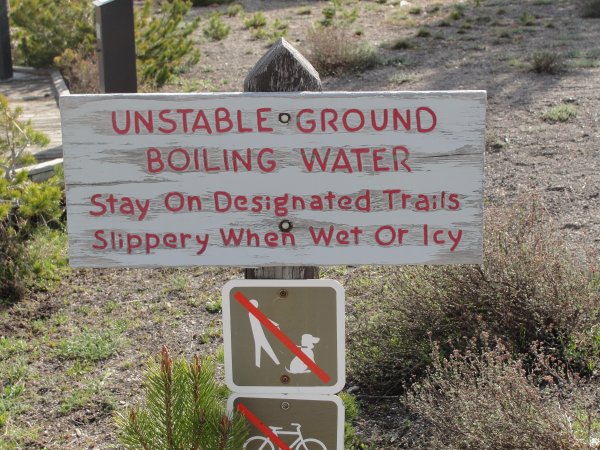 We
parked at the Lower Basin and the first sign you see is this warning
about unstable ground, boiling water. One sign further in told of
a man who tried to rescue his dog which jumped in, and both he and the
dog were killed. We
parked at the Lower Basin and the first sign you see is this warning
about unstable ground, boiling water. One sign further in told of
a man who tried to rescue his dog which jumped in, and both he and the
dog were killed. |
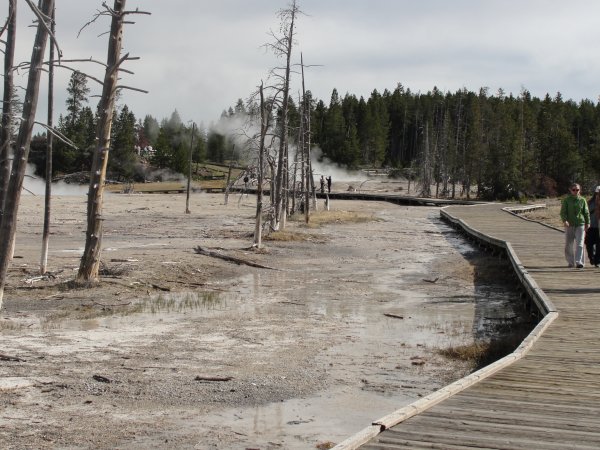 This
is the beginning of the walkway around the Lower Basin. To the
left are Bobby Sox pines. This
is the beginning of the walkway around the Lower Basin. To the
left are Bobby Sox pines. |
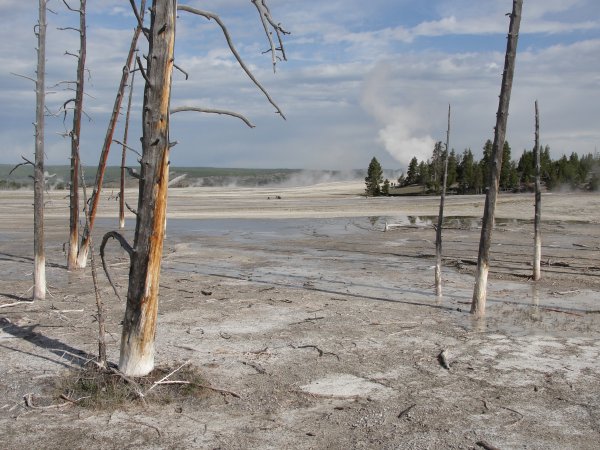
These are lodgepole pines that died by shifting hot spring run-off. By
capillary action the trees soaked up mineral laden water, which colors
their bases white and retards decay. Dissolved minerals in the water
deposited a crust of white silica on the bottom of the dead trees and
stumps. This silica, a non-crystalline compound, slowly impregnates the
wood and over time, with the absence of oxygen, could eventually petrify
the wood. These skeletons have stood here for decades. In the 1950′s
they were referred to as Bobby Sock Trees and the name has stuck.
You can get a feel for the area this basin covers looking through the
pines.
|
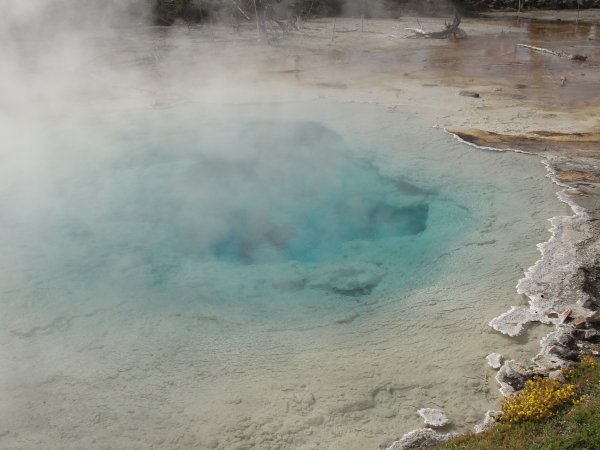 This
is the fountain paint pot. There were a bunch of paint pots
throughout the park. The colors are caused by minerals and
bacteria that thrive in the super heated water. This
is the fountain paint pot. There were a bunch of paint pots
throughout the park. The colors are caused by minerals and
bacteria that thrive in the super heated water.
This was the first attraction along the trail in the lower basin. |
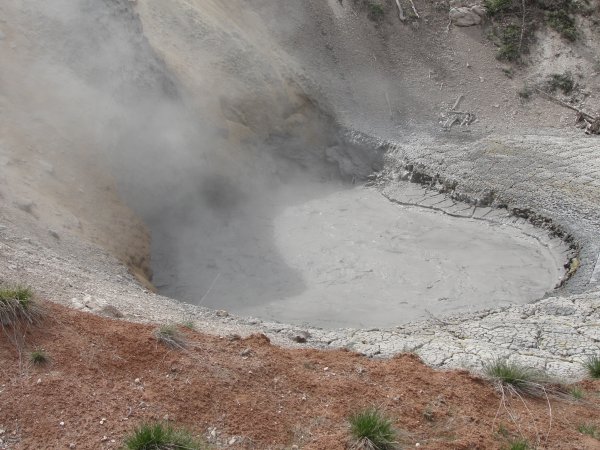
The second attraction was a mud pot that didn't photograph well because
of the steam rising from it. This is a picture of one from a
different part of the park. This stuff becomes clay.
Click here for a
YouTube
of a bubbling Mud Pot.
(not my video) |
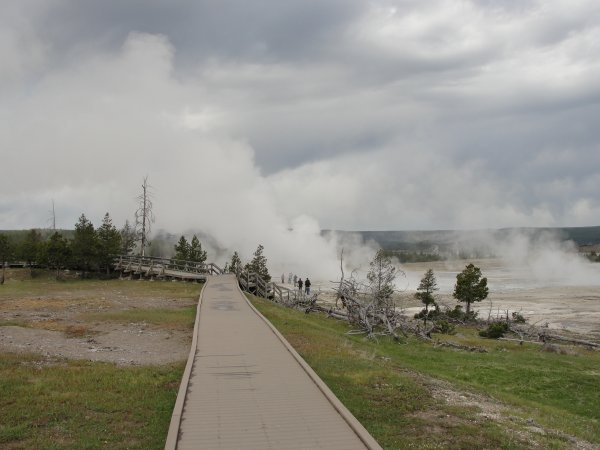
After leaving the paint and mud pots we walked a little ways up to the
site of about four geysers. They weren't big. The one you
see just to the right of the walkway is "spasm" geyser. |

At the Midway Basin there were two major attractions along with some
paint pots. This is "Grand Prismatic Springs." Hot springs
with a myriad of colors caused by high temperature bacteria. You
can't get a feel for the size of these springs because the steam is
covering up much of it.
In person, the steam is not so dense that you can't see through it, I
think the camera catches more reflection off the steam that keeps it
from "penetrating."
|
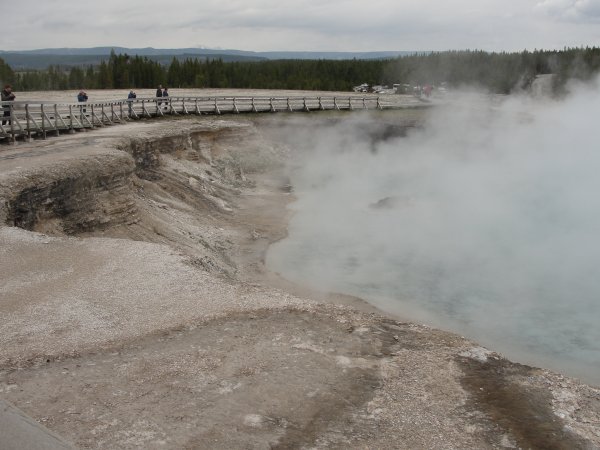
This is Exelsior Geyser. Its eruptions are unpredictable and
apparently used to be violent enough to carve out the huge depression
you see here. The actual opening of the geyser is under
water. You can see the water under the steam. |
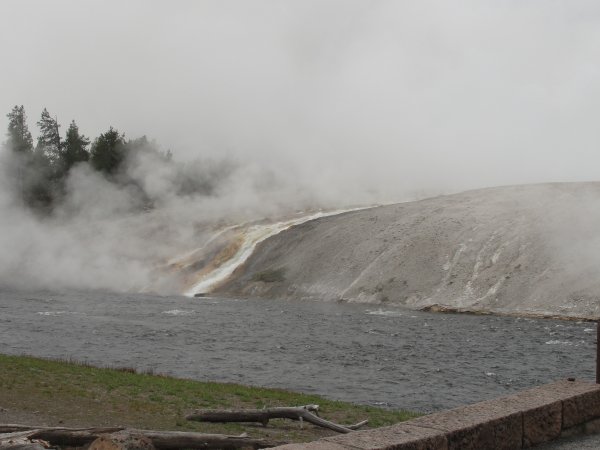
To get to Midway basin you parked and walked across a bridge over a
small river. Hot water from Excelsior Geyser runs down the slope
from the geyser into the river. Apparently the crater of the
geyser is fed with hot water from springs.
From here it's on to the upper basin and Old Faithful. |
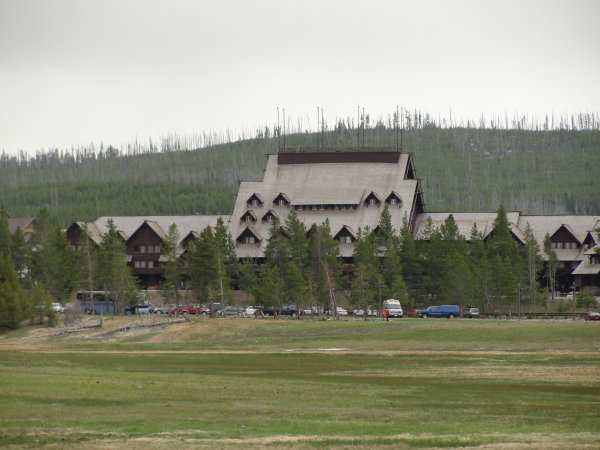 This
is Yellowstone Lodge. It is just a couple of hundred feet from Old
Faithful. I understand reservations have to be made a year in
advance. We didn't even try, and I liked where we stayed. It
appears to be closer to all the attractions and it had all the modern
amenities, such as cable tv and there was a really nice selection of
places to eat in West Yellowstone. In other words, don't be upset
if you don't get a room here. This
is Yellowstone Lodge. It is just a couple of hundred feet from Old
Faithful. I understand reservations have to be made a year in
advance. We didn't even try, and I liked where we stayed. It
appears to be closer to all the attractions and it had all the modern
amenities, such as cable tv and there was a really nice selection of
places to eat in West Yellowstone. In other words, don't be upset
if you don't get a room here. |
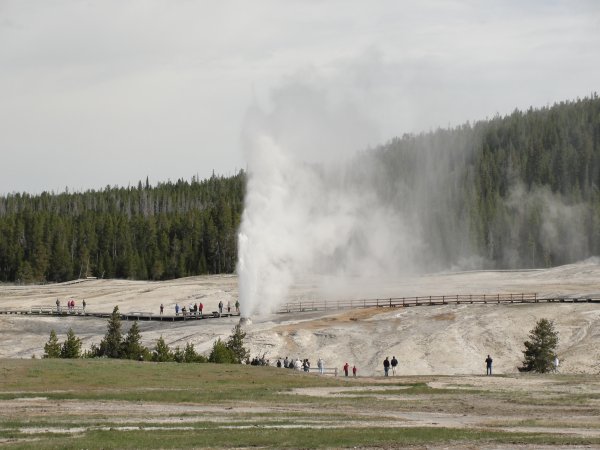 We
were in the visitor center where they have a clock that tells when the
next eruption of Old Faithful will occur, plus or minus ten minutes.
(It's not quite as regular as rumor has it). We
were in the visitor center where they have a clock that tells when the
next eruption of Old Faithful will occur, plus or minus ten minutes.
(It's not quite as regular as rumor has it).
While we were trying to decide what to do a park ranger came in
shouting, Bee Hive is going to erupt, so we went running out in time to
take this picture. It's called bee hive because of the shape of
the cone. It doesn't have a regular eruption cycle, but steam
venting from a nearby by crevice lets the rangers know that it is about
to erupt. Old faithful is just a
few hundred yards to the right of Bee Hive. We decided to take the
walking trail through the upper basin and watch Old Faithful when we
return. The walkway behind Bee Hive is the end of the walkway loop
and continues to Old Faithful.
Video on Youtube of
Beehive erupting (not my video) |
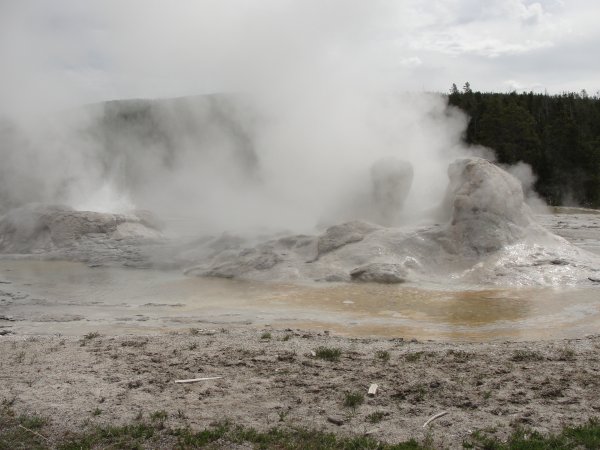 Grotto
Geyser is unusual in the humps that surround it. They think that
when it first erupted it left a few tree trunks remaining which became
encased in minerals. Grotto
Geyser is unusual in the humps that surround it. They think that
when it first erupted it left a few tree trunks remaining which became
encased in minerals. |
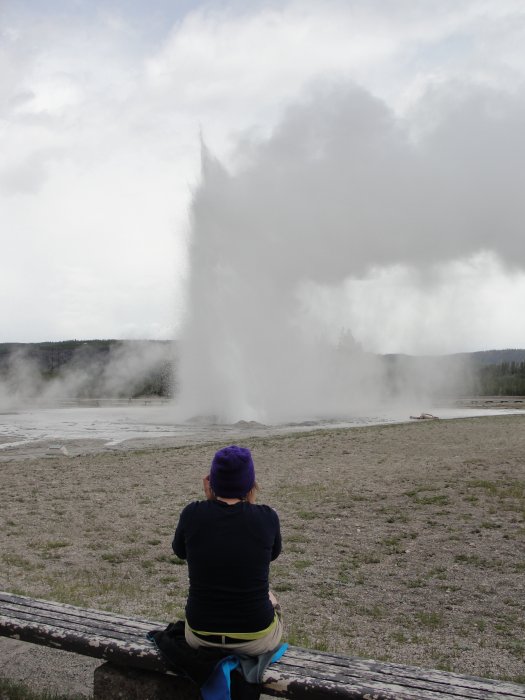
The main walkway continued to River Geyser, a geyser near the river
running through this part of the park. It wasn't going to erupt
anytime soon so we took a side trail to Black Sand Pool. On the
way was Daisy Geyser, which erupted while we were there.
YouTube video of
Daisy Geyser
(3 minutes, but you don't have to
watch it all.) Click here. Also not my video, the music is
optional |
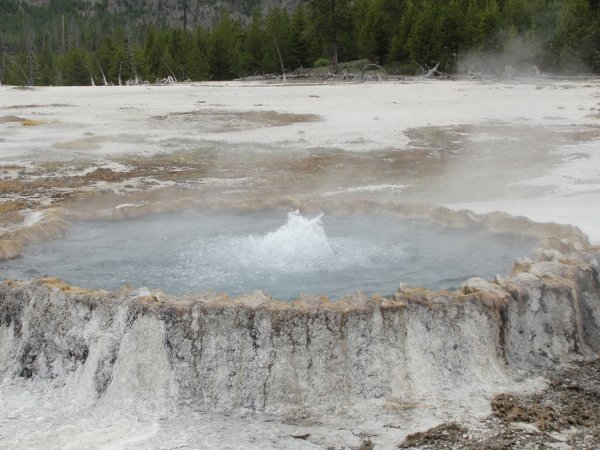
Further along the trail was Punch Bowl Spring, you can see why it is
named Punch Bowl.
Click here for a
short
YouTube video of
Punch bowl bubbling. Not my video |
 This
was the end of Black Sand Trail. There was one of these pools that
just before it erupted it would thumb, and you could hear it and feel
it. I thought it was this one but nothing in the guide book said
anything about it thumping. This
was the end of Black Sand Trail. There was one of these pools that
just before it erupted it would thumb, and you could hear it and feel
it. I thought it was this one but nothing in the guide book said
anything about it thumping. |
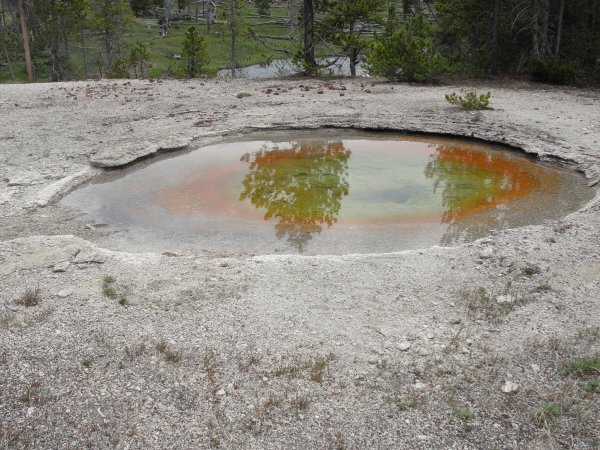 As
we walked along the trail returning to Old Faithful there were several
of these chromatic pools. I like the way the trees are reflected
in this one. They weren't real big, this one was probably about 8
feet across. As
we walked along the trail returning to Old Faithful there were several
of these chromatic pools. I like the way the trees are reflected
in this one. They weren't real big, this one was probably about 8
feet across. |
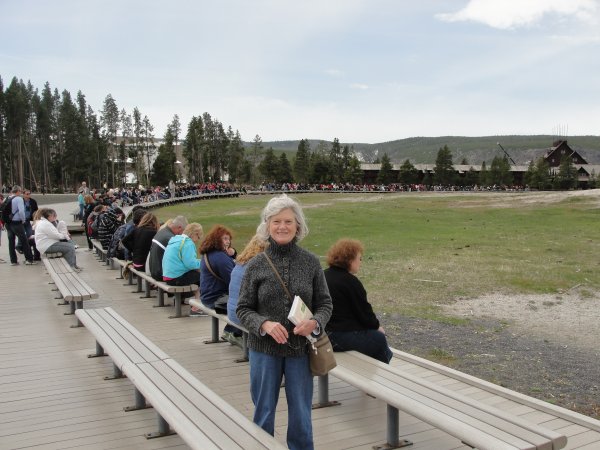
We got back to Old Faithful and waited at the bleachers. |

And the wait was worth it. The eruption lasts a few minutes.
All these geysers work by underground water being heated until the
pressure is high enough to force it through the geyser opening.
And that's the end of the South Route. Click on the North Route
tab below to continue viewing pictures of our trip to Yellowstone
Click here for
YouTube
Of Old Faithful (My Video) |


